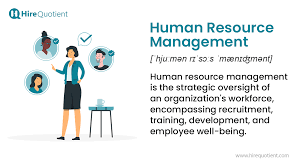Introduction to Human Resource Management (HRM)
Human Resource Management (HRM) is the strategic approach to the effective management of people in an organization, aiming to help the business gain a competitive advantage. It is designed to maximize employee performance in service of an employer's strategic objectives. Human Resource Management is primarily concerned with the management of people within organizations, focusing on policies and systems.
Key Functions of Human Resource Management

- Recruitment and Selection
Recruitment and selection are fundamental elements of Human Resource Management. The process involves identifying vacancies, attracting candidates, and selecting the most suitable individuals to fill those positions. Recruitment is the process of attracting candidates, while selection involves choosing the right candidate for the job. HR professionals must ensure that the recruitment process is free from bias and discrimination, promoting equal opportunities for all candidates.
- Training and Development
Once employees are onboard, the focus shifts to training and development. This involves providing employees with the necessary skills and knowledge to perform their duties effectively. Training and development programs are crucial for employee growth and organizational success. HR managers must identify the training needs of employees and develop programs that enhance their skills and capabilities.
- Performance Management
Performance management is a critical function of HRM. It involves evaluating and improving employee performance to align with organizational goals. This process includes setting clear expectations, providing regular feedback, and conducting performance appraisals. Performance management helps in identifying high performers and areas where employees need improvement.
- Compensation and Benefits
Compensation and benefits are essential components of HRM. They play a significant role in attracting, motivating, and retaining employees. HR managers must design competitive compensation packages that include salaries, bonuses, and benefits such as health insurance, retirement plans, and paid time off. Compensation should be aligned with industry standards and reflect the value of the employee’s contributions to the organization.
- Employee Relations
Employee relations is the management of relationships between employers and employees. It involves addressing employee concerns, resolving conflicts, and promoting a positive work environment. HR managers play a vital role in fostering good employee relations, which can lead to increased job satisfaction and productivity.
- Compliance with Labor Laws
HRM is responsible for ensuring that the organization complies with labor laws and regulations. This includes adhering to laws related to wages, working hours, discrimination, and workplace safety. HR professionals must stay updated with changes in labor laws and ensure that the organization’s policies are in compliance.
Strategic Human Resource Management (SHRM)
- Aligning HRM with Organizational Goals
Strategic Human Resource Management (SHRM) involves aligning HRM strategies with the overall goals of the organization. This approach ensures that HRM contributes to the long-term success of the organization. SHRM focuses on workforce planning, talent management, and succession planning to ensure that the organization has the right people in place to achieve its objectives.
- Talent Management
Talent management is a critical aspect of SHRM. It involves identifying, developing, and retaining top talent within the organization. Effective talent management strategies include succession planning, leadership development programs, and employee engagement initiatives. Talent management ensures that the organization has a pipeline of skilled employees ready to take on leadership roles.
- Workforce Planning
Workforce planning is the process of analyzing and forecasting the needs of the organization in terms of workforce size, skills, and competencies. This involves identifying gaps in the current workforce and developing strategies to address those gaps. Workforce planning is essential for ensuring that the organization has the right people in the right roles at the right time.
The Role of Technology in HRM
- Human Resource Information Systems (HRIS)
Technology has revolutionized HRM, making it more efficient and data-driven. Human Resource Information Systems (HRIS) are software solutions that streamline HR processes such as recruitment, payroll, performance management, and employee data management. HRIS allows HR professionals to manage large volumes of data efficiently and make informed decisions based on real-time data.
- E-Recruitment
E-recruitment is the use of online platforms and tools to attract and hire candidates. This includes job boards, social media, and company websites. E-recruitment makes the hiring process faster and more efficient by reaching a larger pool of candidates and allowing for online applications and automated screening processes.
- Remote Work and HRM
The rise of remote work has transformed the way HRM functions. HR professionals now need to manage remote teams, ensure compliance with remote work policies, and address the unique challenges of remote work, such as communication and collaboration. Technology plays a crucial role in supporting remote work by providing tools for virtual meetings, project management, and employee engagement.
Challenges in Human Resource Management
- Managing Diversity and Inclusion
Diversity and inclusion are critical challenges in HRM. Organizations must create inclusive environments where all employees feel valued and respected, regardless of their background. HR professionals need to implement diversity and inclusion policies, provide training on unconscious bias, and promote a culture of respect and equality.
- Employee Engagement
Employee engagement is another significant challenge in HRM. Engaged employees are more productive, loyal, and committed to the organization’s success. HR managers must develop strategies to enhance employee engagement, such as recognition programs, career development opportunities, and open communication channels.
- Adapting to Changing Workforce Dynamics
The workforce is constantly evolving, with changes in demographics, work preferences, and technology. HR professionals must adapt to these changes by staying updated with trends and continuously evolving their HR strategies. This includes addressing the needs of a multi-generational workforce, managing remote and hybrid work models, and leveraging technology to enhance HR processes.
Conclusion
Human Resource Management is a dynamic and evolving field that plays a critical role in the success of any organization. From recruitment and selection to training and development, performance management, and compliance with labor laws, HRM encompasses a wide range of functions that are essential for managing people effectively. As organizations continue to evolve, HR professionals must stay ahead of the curve by adopting strategic HRM practices and leveraging technology to enhance HR processes.